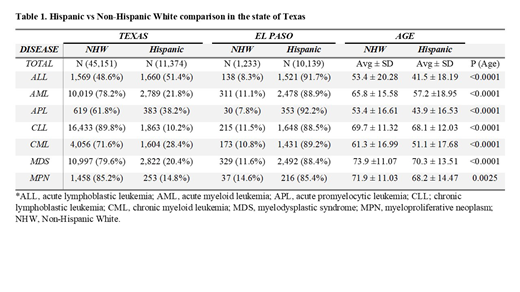Introduction: Hispanics represent the largest minority group in the United States (U.S.), with 57.5 million individuals (18% of the population). Most U.S. Hispanics are of Mexican origin (63.2%), followed by Puerto Rican (9.5%), Cuban (3.9%), Salvadoran (3.8%), and Dominican (3.3%), but distribution varies by state. The majority of Hispanics in the U.S. reside in the Southwest region, and >11 million live in the state of Texas. Cancer is the leading cause of death in the Hispanic population, accounting for 21% of deaths in people of all ages. Health disparities for Hispanic cancer patients have previously been linked to disproportionate poverty and other barriers to optimal healthcare, and in the case of acute myeloid leukemia (AML) and acute lymphoblastic leukemia (ALL), Hispanics were found to be diagnosed younger and to have worse overall survival (OS) than Non-Hispanic whites (NHWs) (ACS. Cancer Facts & Figures for Hispanics/Latinos 2018-2020). However, little is known about incidence and survival for Hispanic blood cancer patients residing at the U.S./Mexico border. To understand the impact of Hispanic ethnicity on outcomes for blood cancer patients diagnosed in this area, we examined OS in adult patients with hematologic malignancies throughout the state of Texas compared to Texas Health Service Region (HSR) 10, encompassing El Paso County.
Methods: We retrospectively reviewed data available from the Texas Cancer Registry for hematologic malignancies diagnosed in the state of Texas between 1995 and 2016, focusing our analysis on chronic and acute leukemias (both myeloid and lymphoid), myelodysplastic syndrome (MDS), and myeloproliferative neoplasms (MPNs). Survival for Hispanic and NHW groups was compared using the log-rank test, and Cox regression analyses adjusting for age and diagnosis. Differences in age at diagnosis were evaluated using t-tests and generalized linear models. Similar analyses compared Hispanic patients from HSR 10 versus Hispanic patients from the rest of Texas. Research was conducted according to a local Institutional Review Board-approved protocol in accordance with the Declaration of Helsinki.
Results: Of the 69,941 cases of hematologic malignancies with available information throughout the state of Texas, 18.29% self-identified as Hispanic. Surprisingly, in unadjusted analyses, Hispanic patients had significantly better OS than NHWs diagnosed with AML (p<0.0001), MDS (p<0.0001), and chronic myeloid leukemia (CML, p<0.0001), with no significant differences in OS for patients with ALL, MPN, acute promyelocytic leukemia (APL), or chronic lymphocytic leukemia (CLL). However, Hispanic patients were diagnosed at a significantly younger age in all diseases analyzed (Table 1), possibly explaining the improved survival. After adjusting for age, ALL (HR 1.32, p<.0001), CLL (HR 1.11, p=0.002), and CML (HR 1.15, p=0.008) showed significantly worse outcomes for Hispanics, with better outcomes in MDS (HR 0.92, p=0.0004), and no significant differences for AML, APL or MPN. Running the same analyses for the entire El Paso population versus the rest of Texas, we found no significant interaction except for a suggestion of a greater ethnic disparity in CML patients from El Paso (p=0.06). We also compared Hispanic patients diagnosed in El Paso versus Hispanics from the rest of Texas. Hispanics in El Paso had a significant reduction in OS compared to Hispanics in other areas of Texas for patients with ALL (p=0.0164), AML (p<0.0001), and CML (p=0.0160), but not for patients with APL, CLL, MDS, or MPN. Again the negative effects become less marked after adjustment for age, as those diagnosed in El Paso tended to be 3 years older at diagnosis than elsewhere in Texas. In analyses adjusted for age and diagnosis, there was again a suggestion that differences between El Paso and the rest of Texas were greater in Hispanics than NHW (p=0.08).
Conclusions: While Hispanic patients with AML, MDS, and CML had significantly better OS compared to NHWs in Texas as a whole, this could be explained by a significant reduction in the age of diagnosis for Hispanics. However, when comparing across Texas, El Paso Hispanics with ALL, AML, and CML have a worse prognosis than in the rest of the state. There appears to be evidence that disparities in outcome by ethnicity may be different in El Paso compared with the rest of Texas. Further study is required to identify factors responsible for the disparity in OS.
No relevant conflicts of interest to declare.
Author notes
Asterisk with author names denotes non-ASH members.


This feature is available to Subscribers Only
Sign In or Create an Account Close Modal